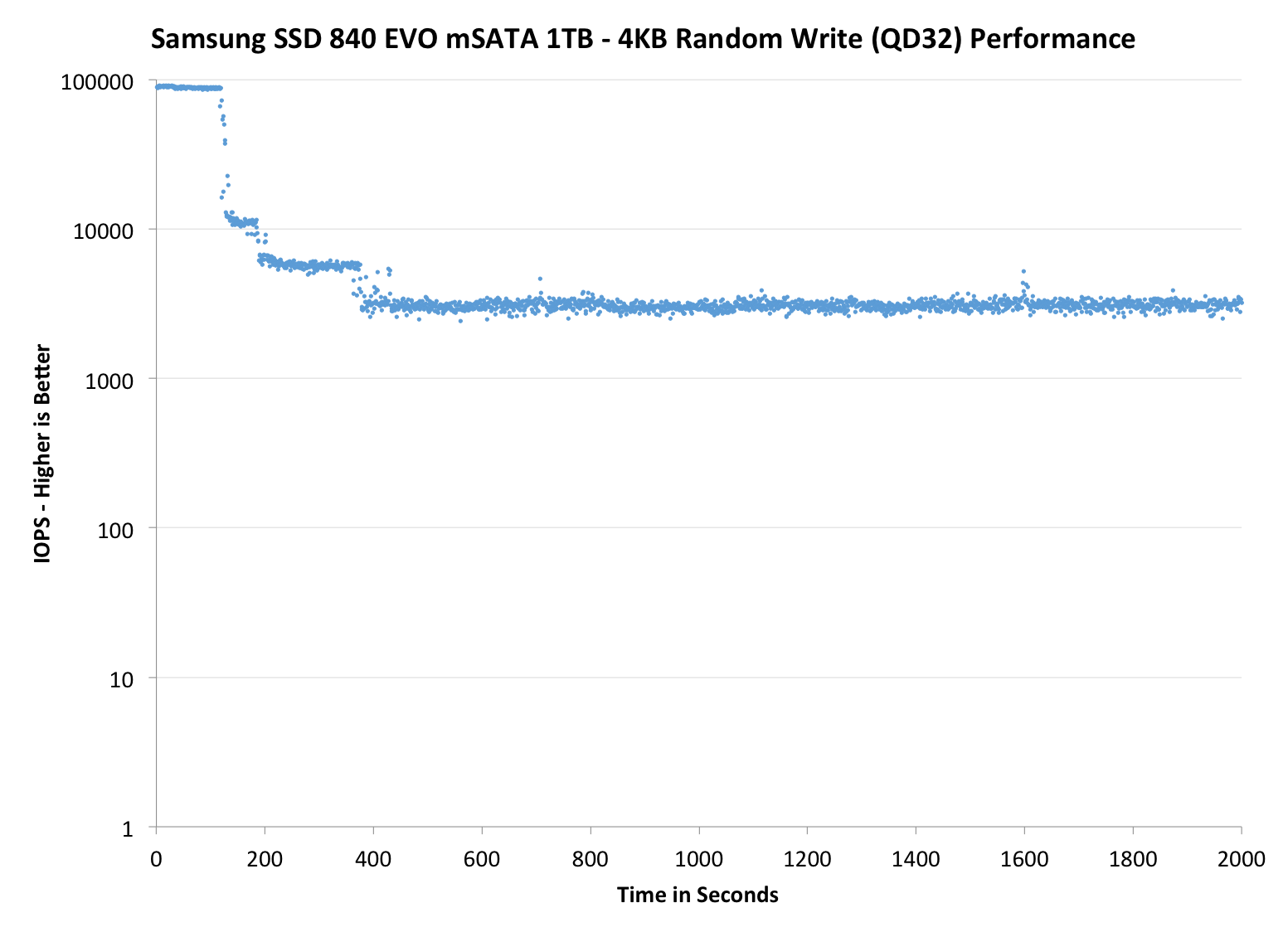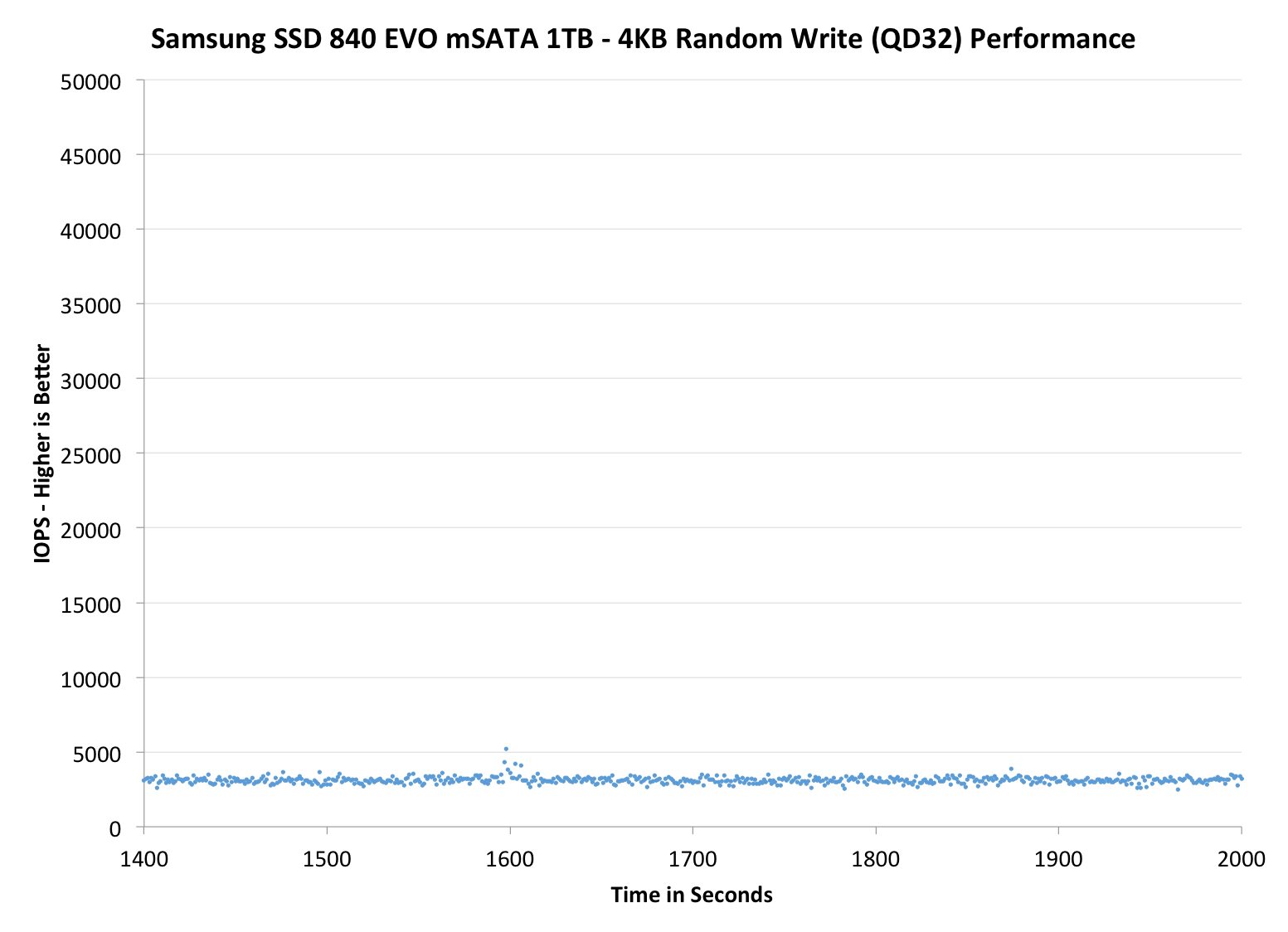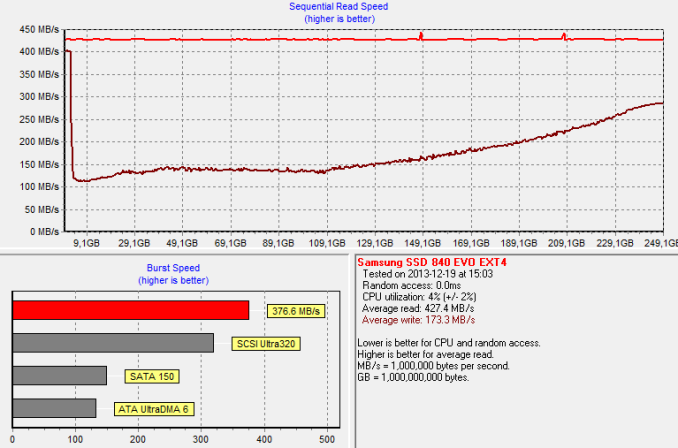Samsung SSD 840 EVO mSATA (120GB, 250GB, 500GB & 1TB) Review
by Kristian Vättö on January 9, 2014 1:35 PM ESTPerformance Consistency
In our Intel SSD DC S3700 review Anand introduced a new method of characterizing performance: looking at the latency of individual operations over time. The S3700 promised a level of performance consistency that was unmatched in the industry, and as a result needed some additional testing to show that. The reason we don't have consistent IO latency with SSDs is because inevitably all controllers have to do some amount of defragmentation or garbage collection in order to continue operating at high speeds. When and how an SSD decides to run its defrag and cleanup routines directly impacts the user experience. Frequent (borderline aggressive) cleanup generally results in more stable performance, while delaying that can result in higher peak performance at the expense of much lower worst-case performance. The graphs below tell us a lot about the architecture of these SSDs and how they handle internal defragmentation.
To generate the data below we take a freshly secure erased SSD and fill it with sequential data. This ensures that all user accessible LBAs have data associated with them. Next we kick off a 4KB random write workload across all LBAs at a queue depth of 32 using incompressible data. We run the test for just over half an hour, nowhere near what we run our steady state tests for but enough to give a good look at drive behavior once all spare area fills up.
We record instantaneous IOPS every second for the duration of the test and then plot IOPS vs. time and generate the scatter plots below. Each set of graphs features the same scale. The first two sets use a log scale for easy comparison, while the last set of graphs uses a linear scale that tops out at 40K IOPS for better visualization of differences between drives.
The high level testing methodology remains unchanged from our S3700 review. Unlike in previous reviews however, we vary the percentage of the drive that gets filled/tested depending on the amount of spare area we're trying to simulate. The buttons are labeled with the advertised user capacity had the SSD vendor decided to use that specific amount of spare area. If you want to replicate this on your own all you need to do is create a partition smaller than the total capacity of the drive and leave the remaining space unused to simulate a larger amount of spare area. The partitioning step isn't absolutely necessary in every case but it's an easy way to make sure you never exceed your allocated spare area. It's a good idea to do this from the start (e.g. secure erase, partition, then install Windows), but if you are working backwards you can always create the spare area partition, format it to TRIM it, then delete the partition. Finally, this method of creating spare area works on the drives we've tested here but not all controllers are guaranteed to behave the same way.
The first set of graphs shows the performance data over the entire 2000 second test period. In these charts you'll notice an early period of very high performance followed by a sharp dropoff. What you're seeing in that case is the drive allocating new blocks from its spare area, then eventually using up all free blocks and having to perform a read-modify-write for all subsequent writes (write amplification goes up, performance goes down).
The second set of graphs zooms in to the beginning of steady state operation for the drive (t=1400s). The third set also looks at the beginning of steady state operation but on a linear performance scale. Click the buttons below each graph to switch source data.
 |
|||||||||
| Samsung SSD 840 EVO mSATA 1TB | Mushkin Atlas 240GB | Intel SSD 525 | Plextor M5M | Samsung SSD 840 EVO 1TB | |||||
| Default | |||||||||
| 25% OP | - | - | |||||||
As expected, IO consistency is mostly similar to the regular EVO. The only change appears to be in steady-state behavior where the 2.5" EVO exhibits more up-and-down behavior, whereas the EVO mSATA is more consistent. This might be due to the latest firmware update because it changed some TurboWrite algorithms and it seems that the TurboWrite is kicking in in the 2.5" EVO every once in a while to boost performance (our EVO mSATA has the latest firmware but the 2.5" EVO was tested with the original firmware).
Increasing the OP in the EVO mSATA results in noticeably better performance but also causes some weird behavior. After about 300 seconds, the IOPS repeatedly drops to 1000 until it evens out after 800 seconds. I am not sure what exactly is happening here but I have asked Samsung to check if this is normal and if they can provide an explanation. My educated guess would be TurboWrite (again) because the drive seems to be reorganizing blocks to increase performance back to peak level. If you're focusing too much on reorganizing existing blocks of data, the latency for incoming writes will increase (and IOPS will drop).
 |
|||||||||
| Samsung SSD 840 EVO mSATA 1TB | Mushkin Atlas 240GB | Intel SSD 525 | Plextor M5M | Samsung SSD 840 EVO 1TB | |||||
| Default | |||||||||
| 25% OP | - | - | |||||||
 |
|||||||||
| Samsung SSD 840 EVO mSATA 1TB | Mushkin Atlas 480GB | Intel SSD 525 | Plextor M5M | Samsung SSD 840 EVO 1TB | |||||
| Default | |||||||||
| 25% OP | - | - | |||||||
TRIM Validation
To test TRIM, I first filled all user-accessible LBAs with sequential data and continued with torturing the drive with 4KB random writes (100% LBA, QD=32) for 60 minutes. After the torture I TRIM'ed the drive (quick format in Windows 7/8) and ran HD Tach to make sure TRIM is functional.
Surprisingly, it's not. The write speed should be around 300MB/s for the 250GB model based on our Iometer test but here the performance is only 100-150MB/s for the earliest LBAs. Sequential writes do restore performance slowly but even after a full drive the performance has not fully recovered.
| Samsung SSD 840 EVO mSATA Resiliency - Iometer Sequential Write | |||
| Clean | Dirty (40min torture) | After TRIM | |
| Samsung SSD 840 EVO mSATA 120GB | 180.4MB/s | 69.3MB/s | 126.2MB/s |
At first I thought this was an error in our testing but I was able to duplicate the issue with our 120GB sample and using Iometer for testing (i.e. 60-second sequential write run in Iometer instead of HD Tach). Unfortunately I ran out of time to test this issue more thoroughly (e.g. does a short period of idling help) but I'll be sure to run more tests once I get back to my testbed.











65 Comments
View All Comments
5mpx - Friday, January 10, 2014 - link
I recently picked up a Samsung 840 Pro 120GB for around $115 to replace the absolutely dreadful Samsung 1TB 5400RPM w/ 8GB SanDisk iSSD ExpressCache (which also seemed absolutely useless) on mainboard.Couldn't be happer - my Core i7 actually has to do some work now instead of sitting around waiting on the drive to feed it data.
dgingeri - Thursday, January 9, 2014 - link
I bet a ship from the future crashed in Seoul, and Samsung is out there reverse engineering technology from it to dominate the technology market. ;)Jarn - Thursday, January 9, 2014 - link
With these speeds, I just go with whichever of the seemingly most reliable brands are cheapest.BigAnvil - Friday, January 10, 2014 - link
Please, oh please, oh please, oh please... let someone make a miniature RAID box for mSata SSDs!!!!!!!!! Room for five mSata SSDs like this with striping and either a Thunderbolt 2 or USB 3.1 interface so we can all have multi-Gigabyte/sec transfer rates that can fit in ur shirt pocketses.Brenderick - Saturday, February 15, 2014 - link
http://www.mfactors.com/raid-card-msata/Not five, but it will cram a pair of them under a RAID controller into a 2.5 inch package. You could, in theory, RAID three of these together in a NAS and you would have what you are describing.
a1exh - Friday, January 10, 2014 - link
Samsung are not the only Vertically Integrated provider in consumer SSD space. Toshiba is also.Kristian Vättö - Friday, January 10, 2014 - link
Toshiba doesn't make their own controllers, they are just rebrands.Brenderick - Saturday, February 15, 2014 - link
Lacks controller IP.unclebump2013 - Friday, January 10, 2014 - link
it does exist. http://addonics.com/products/ad4mspx2.phpextide - Friday, January 10, 2014 - link
No, that's for mSATA, not M.2